Xiaolong Liu
Huazhong University of Science and Technology
Seeing the Invisible: Machine learning-Based QPI Kernel Extraction via Latent Alignment
Jun 05, 2025Abstract:Quasiparticle interference (QPI) imaging is a powerful tool for probing electronic structures in quantum materials, but extracting the single-scatterer QPI pattern (i.e., the kernel) from a multi-scatterer image remains a fundamentally ill-posed inverse problem. In this work, we propose the first AI-based framework for QPI kernel extraction. We introduce a two-step learning strategy that decouples kernel representation learning from observation-to-kernel inference. In the first step, we train a variational autoencoder to learn a compact latent space of scattering kernels. In the second step, we align the latent representation of QPI observations with those of the pre-learned kernels using a dedicated encoder. This design enables the model to infer kernels robustly even under complex, entangled scattering conditions. We construct a diverse and physically realistic QPI dataset comprising 100 unique kernels and evaluate our method against a direct one-step baseline. Experimental results demonstrate that our approach achieves significantly higher extraction accuracy, and improved generalization to unseen kernels.
Training Large Recommendation Models via Graph-Language Token Alignment
Feb 26, 2025



Abstract:Recommender systems (RS) have become essential tools for helping users efficiently navigate the overwhelming amount of information on e-commerce and social platforms. However, traditional RS relying on Collaborative Filtering (CF) struggles to integrate the rich semantic information from textual data. Meanwhile, large language models (LLMs) have shown promising results in natural language processing, but directly using LLMs for recommendation introduces challenges, such as ambiguity in generating item predictions and inefficiencies in scalability. In this paper, we propose a novel framework to train Large Recommendation models via Graph-Language Token Alignment. By aligning item and user nodes from the interaction graph with pretrained LLM tokens, GLTA effectively leverages the reasoning abilities of LLMs. Furthermore, we introduce Graph-Language Logits Matching (GLLM) to optimize token alignment for end-to-end item prediction, eliminating ambiguity in the free-form text as recommendation results. Extensive experiments on three benchmark datasets demonstrate the effectiveness of GLTA, with ablation studies validating each component.
Robust density estimation over star-shaped density classes
Jan 17, 2025Abstract:We establish a novel criterion for comparing the performance of two densities, $g_1$ and $g_2$, within the context of corrupted data. Utilizing this criterion, we propose an algorithm to construct a density estimator within a star-shaped density class, $\mathcal{F}$, under conditions of data corruption. We proceed to derive the minimax upper and lower bounds for density estimation across this star-shaped density class, characterized by densities that are uniformly bounded above and below (in the sup norm), in the presence of adversarially corrupted data. Specifically, we assume that a fraction $\epsilon \leq \frac{1}{3}$ of the $N$ observations are arbitrarily corrupted. We obtain the minimax upper bound $\max\{ \tau_{\overline{J}}^2, \epsilon \} \wedge d^2$. Under certain conditions, we obtain the minimax risk, up to proportionality constants, under the squared $L_2$ loss as $$ \max\left\{ \tau^{*2} \wedge d^2, \epsilon \wedge d^2 \right\}, $$ where $\tau^* := \sup\left\{ \tau : N\tau^2 \leq \log \mathcal{M}_{\mathcal{F}}^{\text{loc}}(\tau, c) \right\}$ for a sufficiently large constant $c$. Here, $\mathcal{M}_{\mathcal{F}}^{\text{loc}}(\tau, c)$ denotes the local entropy of the set $\mathcal{F}$, and $d$ is the $L_2$ diameter of $\mathcal{F}$.
Reverse Region-to-Entity Annotation for Pixel-Level Visual Entity Linking
Dec 18, 2024



Abstract:Visual Entity Linking (VEL) is a crucial task for achieving fine-grained visual understanding, matching objects within images (visual mentions) to entities in a knowledge base. Previous VEL tasks rely on textual inputs, but writing queries for complex scenes can be challenging. Visual inputs like clicks or bounding boxes offer a more convenient alternative. Therefore, we propose a new task, Pixel-Level Visual Entity Linking (PL-VEL), which uses pixel masks from visual inputs to refer to objects, supplementing reference methods for VEL. To facilitate research on this task, we have constructed the MaskOVEN-Wiki dataset through an entirely automatic reverse region-entity annotation framework. This dataset contains over 5 million annotations aligning pixel-level regions with entity-level labels, which will advance visual understanding towards fine-grained. Moreover, as pixel masks correspond to semantic regions in an image, we enhance previous patch-interacted attention with region-interacted attention by a visual semantic tokenization approach. Manual evaluation results indicate that the reverse annotation framework achieved a 94.8% annotation success rate. Experimental results show that models trained on this dataset improved accuracy by 18 points compared to zero-shot models. Additionally, the semantic tokenization method achieved a 5-point accuracy improvement over the trained baseline.
A Collaborative Ensemble Framework for CTR Prediction
Nov 20, 2024



Abstract:Recent advances in foundation models have established scaling laws that enable the development of larger models to achieve enhanced performance, motivating extensive research into large-scale recommendation models. However, simply increasing the model size in recommendation systems, even with large amounts of data, does not always result in the expected performance improvements. In this paper, we propose a novel framework, Collaborative Ensemble Training Network (CETNet), to leverage multiple distinct models, each with its own embedding table, to capture unique feature interaction patterns. Unlike naive model scaling, our approach emphasizes diversity and collaboration through collaborative learning, where models iteratively refine their predictions. To dynamically balance contributions from each model, we introduce a confidence-based fusion mechanism using general softmax, where model confidence is computed via negation entropy. This design ensures that more confident models have a greater influence on the final prediction while benefiting from the complementary strengths of other models. We validate our framework on three public datasets (AmazonElectronics, TaobaoAds, and KuaiVideo) as well as a large-scale industrial dataset from Meta, demonstrating its superior performance over individual models and state-of-the-art baselines. Additionally, we conduct further experiments on the Criteo and Avazu datasets to compare our method with the multi-embedding paradigm. Our results show that our framework achieves comparable or better performance with smaller embedding sizes, offering a scalable and efficient solution for CTR prediction tasks.
InterFormer: Towards Effective Heterogeneous Interaction Learning for Click-Through Rate Prediction
Nov 15, 2024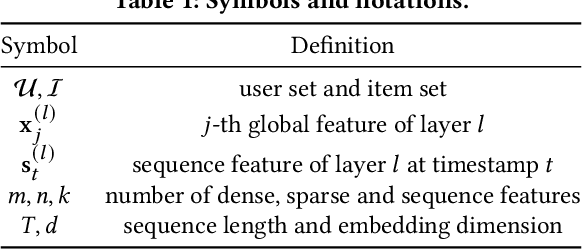
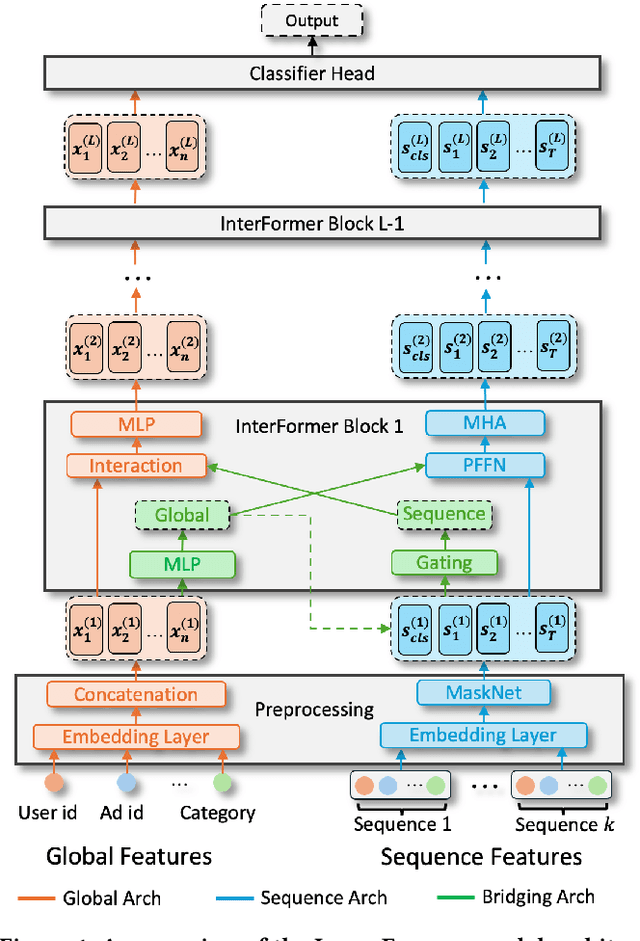

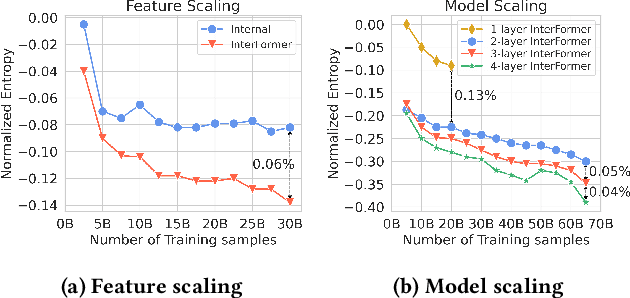
Abstract:Click-through rate (CTR) prediction, which predicts the probability of a user clicking an ad, is a fundamental task in recommender systems. The emergence of heterogeneous information, such as user profile and behavior sequences, depicts user interests from different aspects. A mutually beneficial integration of heterogeneous information is the cornerstone towards the success of CTR prediction. However, most of the existing methods suffer from two fundamental limitations, including (1) insufficient inter-mode interaction due to the unidirectional information flow between modes, and (2) aggressive information aggregation caused by early summarization, resulting in excessive information loss. To address the above limitations, we propose a novel module named InterFormer to learn heterogeneous information interaction in an interleaving style. To achieve better interaction learning, InterFormer enables bidirectional information flow for mutually beneficial learning across different modes. To avoid aggressive information aggregation, we retain complete information in each data mode and use a separate bridging arch for effective information selection and summarization. Our proposed InterFormer achieves state-of-the-art performance on three public datasets and a large-scale industrial dataset.
ScaleKD: Strong Vision Transformers Could Be Excellent Teachers
Nov 11, 2024Abstract:In this paper, we question if well pre-trained vision transformer (ViT) models could be used as teachers that exhibit scalable properties to advance cross architecture knowledge distillation (KD) research, in the context of using large-scale datasets for evaluation. To make this possible, our analysis underlines the importance of seeking effective strategies to align (1) feature computing paradigm differences, (2) model scale differences, and (3) knowledge density differences. By combining three coupled components namely cross attention projector, dual-view feature mimicking and teacher parameter perception tailored to address the above problems, we present a simple and effective KD method, called ScaleKD. Our method can train student backbones that span across a variety of convolutional neural network (CNN), multi-layer perceptron (MLP), and ViT architectures on image classification datasets, achieving state-of-the-art distillation performance. For instance, taking a well pre-trained Swin-L as the teacher model, our method gets 75.15%|82.03%|84.16%|78.63%|81.96%|83.93%|83.80%|85.53% top-1 accuracies for MobileNet-V1|ResNet-50|ConvNeXt-T|Mixer-S/16|Mixer-B/16|ViT-S/16|Swin-T|ViT-B/16 models trained on ImageNet-1K dataset from scratch, showing 3.05%|3.39%|2.02%|4.61%|5.52%|4.03%|2.62%|3.73% absolute gains to the individually trained counterparts. Intriguingly, when scaling up the size of teacher models or their pre-training datasets, our method showcases the desired scalable properties, bringing increasingly larger gains to student models. The student backbones trained by our method transfer well on downstream MS-COCO and ADE20K datasets. More importantly, our method could be used as a more efficient alternative to the time-intensive pre-training paradigm for any target student model if a strong pre-trained ViT is available, reducing the amount of viewed training samples up to 195x.
Knowledge Graph Based Agent for Complex, Knowledge-Intensive QA in Medicine
Oct 07, 2024
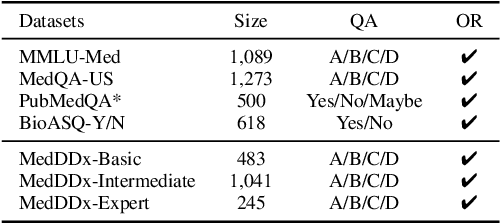
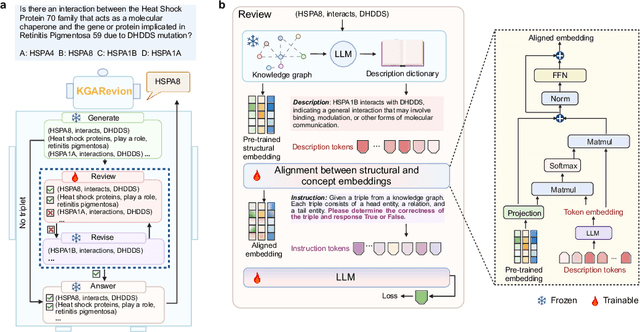
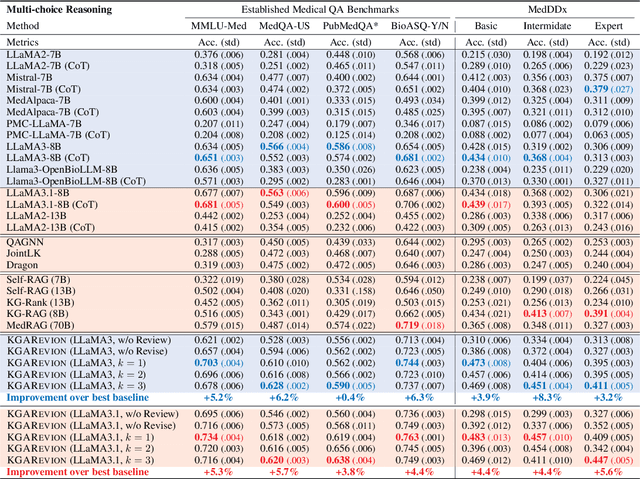
Abstract:Biomedical knowledge is uniquely complex and structured, requiring distinct reasoning strategies compared to other scientific disciplines like physics or chemistry. Biomedical scientists do not rely on a single approach to reasoning; instead, they use various strategies, including rule-based, prototype-based, and case-based reasoning. This diversity calls for flexible approaches that accommodate multiple reasoning strategies while leveraging in-domain knowledge. We introduce KGARevion, a knowledge graph (KG) based agent designed to address the complexity of knowledge-intensive medical queries. Upon receiving a query, KGARevion generates relevant triplets by using the knowledge base of the LLM. These triplets are then verified against a grounded KG to filter out erroneous information and ensure that only accurate, relevant data contribute to the final answer. Unlike RAG-based models, this multi-step process ensures robustness in reasoning while adapting to different models of medical reasoning. Evaluations on four gold-standard medical QA datasets show that KGARevion improves accuracy by over 5.2%, outperforming 15 models in handling complex medical questions. To test its capabilities, we curated three new medical QA datasets with varying levels of semantic complexity, where KGARevion achieved a 10.4% improvement in accuracy.
JoyType: A Robust Design for Multilingual Visual Text Creation
Sep 26, 2024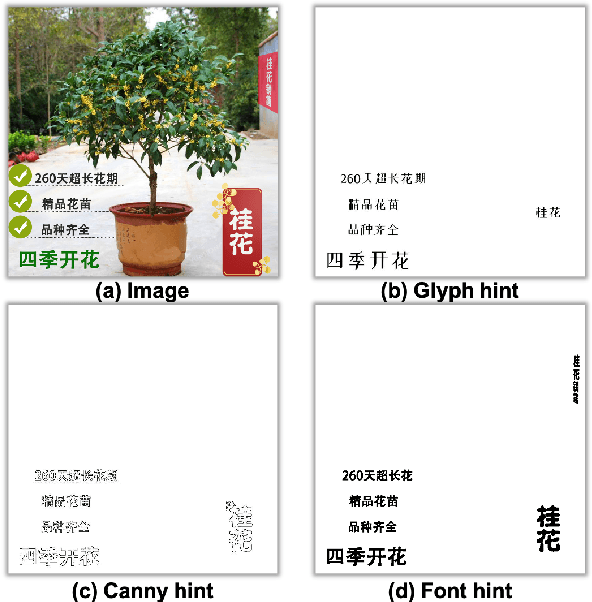



Abstract:Generating images with accurately represented text, especially in non-Latin languages, poses a significant challenge for diffusion models. Existing approaches, such as the integration of hint condition diagrams via auxiliary networks (e.g., ControlNet), have made strides towards addressing this issue. However, diffusion models often fall short in tasks requiring controlled text generation, such as specifying particular fonts or producing text in small fonts. In this paper, we introduce a novel approach for multilingual visual text creation, named JoyType, designed to maintain the font style of text during the image generation process. Our methodology begins with assembling a training dataset, JoyType-1M, comprising 1 million pairs of data. Each pair includes an image, its description, and glyph instructions corresponding to the font style within the image. We then developed a text control network, Font ControlNet, tasked with extracting font style information to steer the image generation. To further enhance our model's ability to maintain font style, notably in generating small-font text, we incorporated a multi-layer OCR-aware loss into the diffusion process. This enhancement allows JoyType to direct text rendering using low-level descriptors. Our evaluations, based on both visual and accuracy metrics, demonstrate that JoyType significantly outperforms existing state-of-the-art methods. Additionally, JoyType can function as a plugin, facilitating the creation of varied image styles in conjunction with other stable diffusion models on HuggingFace and CivitAI. Our project is open-sourced on https://jdh-algo.github.io/JoyType/.
Contrastive Disentangling: Fine-grained representation learning through multi-level contrastive learning without class priors
Sep 07, 2024Abstract:Recent advancements in unsupervised representation learning often leverage class information to enhance feature extraction and clustering performance. However, this reliance on class priors limits the applicability of such methods in real-world scenarios where class information is unavailable or ambiguous. In this paper, we propose Contrastive Disentangling (CD), a simple and effective framework that learns representations without any reliance on class priors. Our framework employs a multi-level contrastive learning strategy that combines instance-level and feature-level losses with a normalized entropy loss to learn semantically rich and fine-grained representations. Specifically, (1) the instance-level contrastive loss encourages the separation of feature representations for different samples, (2) the feature-level contrastive loss promotes independence among the feature head predictions, and (3) the normalized entropy loss encourages the feature heads to capture meaningful and prevalent attributes from the data. These components work together to enable CD to significantly outperform existing methods, as demonstrated by extensive experiments on benchmark datasets including CIFAR-10, CIFAR-100, STL-10, and ImageNet-10, particularly in scenarios where class priors are absent. The code is available at https://github.com/Hoper-J/Contrastive-Disentangling.
 Add to Chrome
Add to Chrome Add to Firefox
Add to Firefox Add to Edge
Add to Edge